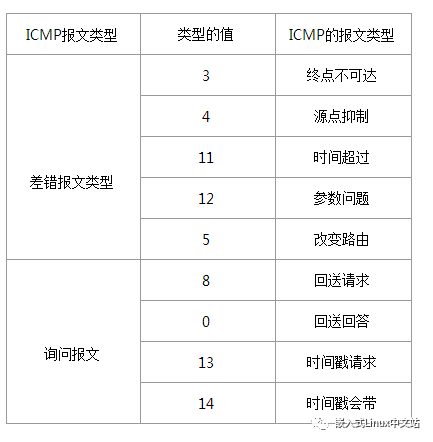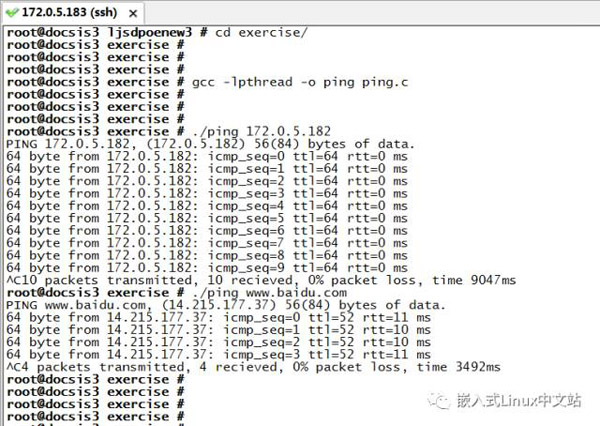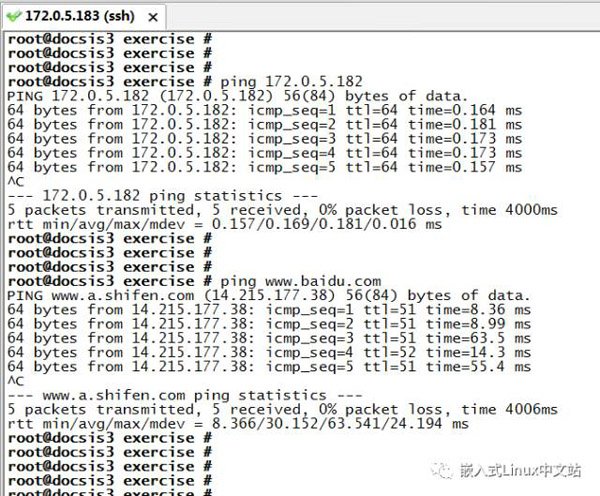这篇文章主要为大家展示了“Linux中PING怎么用”,内容简而易懂,条理清晰,希望能够帮助大家解决疑惑,下面让小编带领大家一起研究并学习一下“Linux中PING怎么用”这篇文章吧。
PING(Packet InterNet Groper)中文名为因特网包探索器,是用来查看网络上另一个主机系统的网络连接是否正常的一个工具。ping命令的工作原理是:向网络上的另一个主机系统发送ICMP报文,如果指定系统得到了报文,它将把回复报文传回给发送者,这有点象潜水艇声纳系统中使用的发声装置。所以,我们想知道我这台主机能不能和另一台进行通信,我们首先需要确认的是我们两台主机间的网络是不是通的,也就是我说的话能不能传到你那里,这是双方进行通信的前提。在Linux下使用指令ping的方法和现象如下:

PING的实现看起来并不复杂,我想自己写代码实现这个功能,需要些什么知识储备?我简单罗列了一下:
ICMP协议的理解
RAW套接字
网络封包和解包技能
搭建这么一个ping程序的步骤如下:
ICMP包的封装和解封
创建一个线程用于ICMP包的发送
创建一个线程用于ICMP包的接收
原始套接字编程
PING的流程如下:

一、ICMP包的封装和解封
(1) ICMP协议理解
要进行PING的开发,我们首先需要知道PING的实现是基于ICMP协议来开发的。要进行ICMP包的封装和解封,我们首先需要理解ICMP协议。ICMP位于网络层,允许主机或者路由器报告差错情况和提供有关异常情况的报告。ICMP报文是封装在IP数据报中,作为其中的数据部分。ICMP报文作为IP层数据报的数据,加上数据报头,组成IP数据报发送出去。ICMP报文格式如下:

ICMP报文的种类有两种,即ICMP差错报告报文和ICMP询问报文。PING程序使用的ICMP报文种类为ICMP询问报文。注意一下上面说到的ICMP报文格式中的“类型”字段,我们在组包的时候可以向该字段填写不同的值来标定该ICMP报文的类型。下面列出的是几种常用的ICMP报文类型。

我们的PING程序需要用到的ICMP的类型是回送请求(8)。
因为ICMP报文的具体格式会因为ICMP报文的类型而各不相同,我们ping包的格式是这样的:

(2) ICMP包的组装
对照上面的ping包格式,我们封装ping包的代码可以这么写:
void icmp_pack(struct icmp* icmphdr, int seq, int length) { int i = 0; icmphdr->icmp_type = ICMP_ECHO; //类型填回送请求 icmphdr->icmp_code = 0; icmphdr->icmp_cksum = 0; //注意,这里先填写0,很重要! icmphdr->icmp_seq = seq; //这里的序列号我们填1,2,3,4.... icmphdr->icmp_id = pid & 0xffff; //我们使用pid作为icmp_id,icmp_id只是2字节,而pid有4字节 for(i=0;i<length;i++) { icmphdr->icmp_data[i] = i; //填充数据段,使ICMP报文大于64B } icmphdr->icmp_cksum = cal_chksum((unsigned short*)icmphdr, length); //校验和计算}这里再三提醒一下,icmp_cksum 必须先填写为0再执行校验和算法计算,否则ping时对方主机会因为校验和计算错误而丢弃请求包,导致ping的失败。我一个同事曾经就因为这么一个错误而排查许久,血的教训请铭记。
这里简单介绍一下checksum(校验和)。
计算机网络通信时,为了检验在数据传输过程中数据是否发生了错误,通常在传输数据的时候连同校验和一块传输,当接收端接受数据时候会从新计算校验和,如果与原校验和不同就视为出错,丢弃该数据包,并返回icmp报文。
算法基本思路:
IP/ICMP/IGMP/TCP/UDP等协议的校验和算法都是相同的,采用的都是将数据流视为16位整数流进行重复叠加计算。为了计算检验和,首先把检验和字段置为0。然后,对有效数据范围内中每个16位进行二进制反码求和,结果存在检验和字段中,如果数据长度为奇数则补一字节0。当收到数据后,同样对有效数据范围中每个16位数进行二进制反码的求和。由于接收方在计算过程中包含了发送方存在首部中的检验和,因此,如果首部在传输过程中没有发生任何差错,那么接收方计算的结果应该为全0或全1(具体看实现了,本质一样) 。如果结果不是全0或全1,那么表示数据错误。
/*校验和算法*/ unsigned short cal_chksum(unsigned short *addr,int len) { int nleft=len; int sum=0; unsigned short *w=addr; unsigned short answer=0; /*把ICMP报头二进制数据以2字节为单位累加起来*/ while(nleft>1) { sum+=*w++; nleft-=2; } /*若ICMP报头为奇数个字节,会剩下***一字节。把***一个字节视为一个2字节数据的高字节,这个2字节数据的低字节为0,继续累加*/ if( nleft==1) { *(unsigned char *)(&answer)=*(unsigned char *)w; sum+=answer; } sum=(sum>>16)+(sum&0xffff); sum+=(sum>>16); answer=~sum; return answer; }(3) ICMP包的解包
知道怎么封装包,那解包就也不难了,注意的是,收到一个ICMP包,我们不要就认为这个包就是我们发出去的ICMP回送回答包,我们需要加一层代码来判断该ICMP报文的id和seq字段是否符合我们发送的ICMP报文的设置,来验证ICMP回复包的正确性。
int icmp_unpack(char* buf, int len) { int iphdr_len; struct timeval begin_time, recv_time, offset_time; int rtt; //round trip time struct ip* ip_hdr = (struct ip *)buf; iphdr_len = ip_hdr->ip_hl*4; struct icmp* icmp = (struct icmp*)(buf+iphdr_len); //使指针跳过IP头指向ICMP头 len-=iphdr_len; //icmp包长度 if(len < 8) //判断长度是否为ICMP包长度 { fprintf(stderr, "Invalid icmp packet.Its length is less than 8\n"); return -1; } //判断该包是ICMP回送回答包且该包是我们发出去的 if((icmp->icmp_type == ICMP_ECHOREPLY) && (icmp->icmp_id == (pid & 0xffff))) { if((icmp->icmp_seq < 0) || (icmp->icmp_seq > PACKET_SEND_MAX_NUM)) { fprintf(stderr, "icmp packet seq is out of range!\n"); return -1; } ping_packet[icmp->icmp_seq].flag = 0; begin_time = ping_packet[icmp->icmp_seq].begin_time; //去除该包的发出时间 gettimeofday(&recv_time, NULL); offset_time = cal_time_offset(begin_time, recv_time); rtt = offset_time.tv_sec*1000 + offset_time.tv_usec/1000; //毫秒为单位 printf("%d byte from %s: icmp_seq=%u ttl=%d rtt=%d ms\n", len, inet_ntoa(ip_hdr->ip_src), icmp->icmp_seq, ip_hdr->ip_ttl, rtt); } else { fprintf(stderr, "Invalid ICMP packet! Its id is not matched!\n"); return -1; } return 0; }二、发包线程的搭建
根据PING程序的框架,我们需要建立一个线程用于ping包的发送,我的想法是这样的:使用sendto进行发包,发包速率我们维持在1秒1发,我们需要用一个全局变量记录***个ping包发出的时间,除此之外,我们还需要一个全局变量来记录我们发出的ping包到底有几个,这两个变量用于后来收到ping包回复后的数据计算。
void ping_send() { char send_buf[128]; memset(send_buf, 0, sizeof(send_buf)); gettimeofday(&start_time, NULL); //记录***个ping包发出的时间 while(alive) { int size = 0; gettimeofday(&(ping_packet[send_count].begin_time), NULL); ping_packet[send_count].flag = 1; //将该标记为设置为该包已发送 icmp_pack((struct icmp*)send_buf, send_count, 64); //封装icmp包 size = sendto(rawsock, send_buf, 64, 0, (struct sockaddr*)&dest, sizeof(dest)); send_count++; //记录发出ping包的数量 if(size < 0) { fprintf(stderr, "send icmp packet fail!\n"); continue; } sleep(1); } }三、收包线程的搭建
我们同样建立一个接收包的线程,这里我们采用select函数进行收包,并为select函数设置超时时间为200us,若发生超时,则进行下一个循环。同样地,我们也需要一个全局变量来记录成功接收到的ping回复包的数量。
void ping_recv() { struct timeval tv; tv.tv_usec = 200; //设置select函数的超时时间为200us tv.tv_sec = 0; fd_set read_fd; char recv_buf[512]; memset(recv_buf, 0 ,sizeof(recv_buf)); while(alive) { int ret = 0; FD_ZERO(&read_fd); FD_SET(rawsock, &read_fd); ret = select(rawsock+1, &read_fd, NULL, NULL, &tv); switch(ret) { case -1: fprintf(stderr,"fail to select!\n"); break; case 0: break; default: { int size = recv(rawsock, recv_buf, sizeof(recv_buf), 0); if(size < 0) { fprintf(stderr,"recv data fail!\n"); continue; } ret = icmp_unpack(recv_buf, size); //对接收的包进行解封 if(ret == -1) //不是属于自己的icmp包,丢弃不处理 { continue; } recv_count++; //接收包计数 } break; } } }四、中断处理
我们规定了一次ping发送的包的***值为64个,若超出该数值就停止发送。作为PING的使用者,我们一般只会发送若干个包,若有这几个包顺利返回,我们就crtl+c中断ping。这里的代码主要是为中断信号写一个中断处理函数,将alive这个全局变量设置为0,进而使发送ping包的循环停止而结束程序。
oid icmp_sigint(int signo) { alive = 0; gettimeofday(&end_time, NULL); time_interval = cal_time_offset(start_time, end_time); } signal(SIGINT, icmp_sigint);五、总体实现
各模块介绍完了,现在贴出完整代码。
#include <stdio.h> #include <netinet/in.h> #include <netinet/ip.h> #include <netinet/ip_icmp.h> #include <unistd.h> #include <signal.h> #include <arpa/inet.h> #include <errno.h> #include <sys/time.h> #include <string.h> #include <netdb.h> #include <pthread.h> #define PACKET_SEND_MAX_NUM 64 typedef struct ping_packet_status { struct timeval begin_time; struct timeval end_time; int flag; //发送标志,1为已发送 int seq; //包的序列号 }ping_packet_status; ping_packet_status ping_packet[PACKET_SEND_MAX_NUM]; int alive; int rawsock; int send_count; int recv_count; pid_t pid; struct sockaddr_in dest; struct timeval start_time; struct timeval end_time; struct timeval time_interval; /*校验和算法*/ unsigned short cal_chksum(unsigned short *addr,int len) { int nleft=len; int sum=0; unsigned short *w=addr; unsigned short answer=0; /*把ICMP报头二进制数据以2字节为单位累加起来*/ while(nleft>1) { sum+=*w++; nleft-=2; } /*若ICMP报头为奇数个字节,会剩下***一字节。把***一个字节视为一个2字节数据的高字节,这个2字节数据的低字节为0,继续累加*/ if( nleft==1) { *(unsigned char *)(&answer)=*(unsigned char *)w; sum+=answer; } sum=(sum>>16)+(sum&0xffff); sum+=(sum>>16); answer=~sum; return answer; } struct timeval cal_time_offset(struct timeval begin, struct timeval end) { struct timeval ans; ans.tv_sec = end.tv_sec - begin.tv_sec; ans.tv_usec = end.tv_usec - begin.tv_usec; if(ans.tv_usec < 0) //如果接收时间的usec小于发送时间的usec,则向sec域借位 { ans.tv_sec--; ans.tv_usec+=1000000; } return ans; } void icmp_pack(struct icmp* icmphdr, int seq, int length) { int i = 0; icmphdr->icmp_type = ICMP_ECHO; icmphdr->icmp_code = 0; icmphdr->icmp_cksum = 0; icmphdr->icmp_seq = seq; icmphdr->icmp_id = pid & 0xffff; for(i=0;i<length;i++) { icmphdr->icmp_data[i] = i; } icmphdr->icmp_cksum = cal_chksum((unsigned short*)icmphdr, length); } int icmp_unpack(char* buf, int len) { int iphdr_len; struct timeval begin_time, recv_time, offset_time; int rtt; //round trip time struct ip* ip_hdr = (struct ip *)buf; iphdr_len = ip_hdr->ip_hl*4; struct icmp* icmp = (struct icmp*)(buf+iphdr_len); len-=iphdr_len; //icmp包长度 if(len < 8) //判断长度是否为ICMP包长度 { fprintf(stderr, "Invalid icmp packet.Its length is less than 8\n"); return -1; } //判断该包是ICMP回送回答包且该包是我们发出去的 if((icmp->icmp_type == ICMP_ECHOREPLY) && (icmp->icmp_id == (pid & 0xffff))) { if((icmp->icmp_seq < 0) || (icmp->icmp_seq > PACKET_SEND_MAX_NUM)) { fprintf(stderr, "icmp packet seq is out of range!\n"); return -1; } ping_packet[icmp->icmp_seq].flag = 0; begin_time = ping_packet[icmp->icmp_seq].begin_time; gettimeofday(&recv_time, NULL); offset_time = cal_time_offset(begin_time, recv_time); rtt = offset_time.tv_sec*1000 + offset_time.tv_usec/1000; //毫秒为单位 printf("%d byte from %s: icmp_seq=%u ttl=%d rtt=%d ms\n", len, inet_ntoa(ip_hdr->ip_src), icmp->icmp_seq, ip_hdr->ip_ttl, rtt); } else { fprintf(stderr, "Invalid ICMP packet! Its id is not matched!\n"); return -1; } return 0; } void ping_send() { char send_buf[128]; memset(send_buf, 0, sizeof(send_buf)); gettimeofday(&start_time, NULL); //记录***个ping包发出的时间 while(alive) { int size = 0; gettimeofday(&(ping_packet[send_count].begin_time), NULL); ping_packet[send_count].flag = 1; //将该标记为设置为该包已发送 icmp_pack((struct icmp*)send_buf, send_count, 64); //封装icmp包 size = sendto(rawsock, send_buf, 64, 0, (struct sockaddr*)&dest, sizeof(dest)); send_count++; //记录发出ping包的数量 if(size < 0) { fprintf(stderr, "send icmp packet fail!\n"); continue; } sleep(1); } } void ping_recv() { struct timeval tv; tv.tv_usec = 200; //设置select函数的超时时间为200us tv.tv_sec = 0; fd_set read_fd; char recv_buf[512]; memset(recv_buf, 0 ,sizeof(recv_buf)); while(alive) { int ret = 0; FD_ZERO(&read_fd); FD_SET(rawsock, &read_fd); ret = select(rawsock+1, &read_fd, NULL, NULL, &tv); switch(ret) { case -1: fprintf(stderr,"fail to select!\n"); break; case 0: break; default: { int size = recv(rawsock, recv_buf, sizeof(recv_buf), 0); if(size < 0) { fprintf(stderr,"recv data fail!\n"); continue; } ret = icmp_unpack(recv_buf, size); //对接收的包进行解封 if(ret == -1) //不是属于自己的icmp包,丢弃不处理 { continue; } recv_count++; //接收包计数 } break; } } } void icmp_sigint(int signo) { alive = 0; gettimeofday(&end_time, NULL); time_interval = cal_time_offset(start_time, end_time); } void ping_stats_show() { long time = time_interval.tv_sec*1000+time_interval.tv_usec/1000; /*注意除数不能为零,这里send_count有可能为零,所以运行时提示错误*/ printf("%d packets transmitted, %d recieved, %d%c packet loss, time %ldms\n", send_count, recv_count, (send_count-recv_count)*100/send_count, '%', time); } int main(int argc, char* argv[]) { int size = 128*1024;//128k struct protoent* protocol = NULL; char dest_addr_str[80]; memset(dest_addr_str, 0, 80); unsigned int inaddr = 1; struct hostent* host = NULL; pthread_t send_id,recv_id; if(argc < 2) { printf("Invalid IP ADDRESS!\n"); return -1; } protocol = getprotobyname("icmp"); //获取协议类型ICMP if(protocol == NULL) { printf("Fail to getprotobyname!\n"); return -1; } memcpy(dest_addr_str, argv[1], strlen(argv[1])+1); rawsock = socket(AF_INET,SOCK_RAW,protocol->p_proto); if(rawsock < 0) { printf("Fail to create socket!\n"); return -1; } pid = getpid(); setsockopt(rawsock, SOL_SOCKET, SO_RCVBUF, &size, sizeof(size)); //增大接收缓冲区至128K bzero(&dest,sizeof(dest)); dest.sin_family = AF_INET; inaddr = inet_addr(argv[1]); if(inaddr == INADDR_NONE) //判断用户输入的是否为IP地址还是域名 { //输入的是域名地址 host = gethostbyname(argv[1]); if(host == NULL) { printf("Fail to gethostbyname!\n"); return -1; } memcpy((char*)&dest.sin_addr, host->h_addr, host->h_length); } else { memcpy((char*)&dest.sin_addr, &inaddr, sizeof(inaddr));//输入的是IP地址 } inaddr = dest.sin_addr.s_addr; printf("PING %s, (%d.%d.%d.%d) 56(84) bytes of data.\n",dest_addr_str, (inaddr&0x000000ff), (inaddr&0x0000ff00)>>8, (inaddr&0x00ff0000)>>16, (inaddr&0xff000000)>>24); alive = 1; //控制ping的发送和接收 signal(SIGINT, icmp_sigint); if(pthread_create(&send_id, NULL, (void*)ping_send, NULL)) { printf("Fail to create ping send thread!\n"); return -1; } if(pthread_create(&recv_id, NULL, (void*)ping_recv, NULL)) { printf("Fail to create ping recv thread!\n"); return -1; } pthread_join(send_id, NULL);//等待send ping线程结束后进程再结束 pthread_join(recv_id, NULL);//等待recv ping线程结束后进程再结束 ping_stats_show(); close(rawsock); return 0; }编译以及实验现象如下:
我的实验环境是两台服务器,发起ping的主机是172.0.5.183,被ping的主机是172.0.5.182,以下是我的两次实验现象(ping IP和ping 域名)。
特别注意:
只有root用户才能利用socket()函数生成原始套接字,要让Linux的一般用户能执行以上程序,需进行如下的特别操作:用root登陆,编译以上程序gcc -lpthread -o ping ping.c

实验现象可以看出,PING是成功的,表明两主机间的网络是通的,发出的所有ping包都收到了回复。
下面是Linux系统自带的PING程序,我们可以对比一下我们设计的PING程序跟系统自带的PING程序有何不同。

以上是“Linux中PING怎么用”这篇文章的所有内容,感谢各位的阅读!相信大家都有了一定的了解,希望分享的内容对大家有所帮助,如果还想学习更多知识,欢迎关注亿速云行业资讯频道!
免责声明:本站发布的内容(图片、视频和文字)以原创、转载和分享为主,文章观点不代表本网站立场,如果涉及侵权请联系站长邮箱:is@yisu.com进行举报,并提供相关证据,一经查实,将立刻删除涉嫌侵权内容。